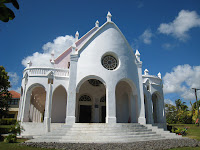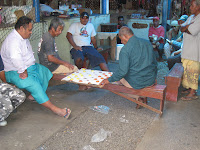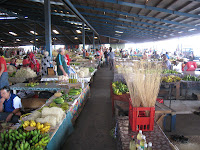I have to take a minute here to talk about the marina. It is a very nice facility. They have
 showers and toilets, and there is water and electricity on the docks. Bellingham Marine designed it, but I don’t know if they actually put it into place. The amazing thing is that Apia did not dredge the area of the marina; consequently, there are coral heads in about 1/3 of the slips—they are unusable. There are also some coral heads in the main channels, which they neglect to tell you when you are pulling in. Other than that, it is a great place to stay. We found out that in order to help pay for the facility, which was built for the Pacific Games last year, all boats that have a draft of 6 feet or less have to stay in the marina. Boats with deeper drafts are allowed to anchor out—you are not given a choice.
showers and toilets, and there is water and electricity on the docks. Bellingham Marine designed it, but I don’t know if they actually put it into place. The amazing thing is that Apia did not dredge the area of the marina; consequently, there are coral heads in about 1/3 of the slips—they are unusable. There are also some coral heads in the main channels, which they neglect to tell you when you are pulling in. Other than that, it is a great place to stay. We found out that in order to help pay for the facility, which was built for the Pacific Games last year, all boats that have a draft of 6 feet or less have to stay in the marina. Boats with deeper drafts are allowed to anchor out—you are not given a choice.Anyway, we decided that we would like to drive around Upolu Island so we reserved a car with a local company for Thursday morning. We got up early and got our gear together, and then Steve went to get the car but came back on foot. I guess in Samoa the word “reserved” does not mean you are guaranteed a car. After checking several places, he ended up at Budget so we took off around 9 o’clock and headed east.

 Our first stop was Piula Cave Pool. This is a freshwater pool that comes through a cave, pools up, and then slowly drains into the ocean. The cave pool is located under a beautiful Methodist church. Unfortunately, we did not have a chance to swim in the pool.
Our first stop was Piula Cave Pool. This is a freshwater pool that comes through a cave, pools up, and then slowly drains into the ocean. The cave pool is located under a beautiful Methodist church. Unfortunately, we did not have a chance to swim in the pool.The next stop was Falefa Waterfall. We saw the sign and turned in to park. A man came out and collected $10 (all prices listed are tala) for us to walk down to see the waterfall. In this case I believe that waterfall was a stretch., but it was a lovely inlet from the sea, and there was a quasi-waterfall.
We then turned inland and drove over La Mata Pass, which is 276
 meters. The views were beautiful, and the vegetation was thick and lush. There were vines growing on everything. On this road we located Fuipisia Waterfall. The Moon Handbook stated that there was a $4 per person fee. We parked the car at the entrance, but a man came out and directed us further down a path that was closer to the falls. Steve went to pay him, but he said we could pay when we left. He and his son walked us down the path to the view of the falls that plunge
meters. The views were beautiful, and the vegetation was thick and lush. There were vines growing on everything. On this road we located Fuipisia Waterfall. The Moon Handbook stated that there was a $4 per person fee. We parked the car at the entrance, but a man came out and directed us further down a path that was closer to the falls. Steve went to pay him, but he said we could pay when we left. He and his son walked us down the path to the view of the falls that plunge 56 meters. It was a beautiful waterfall with a lovely pool at the bottom. Then the man led us up to the top of the falls to look down—a bit unnerving. We took some pictures and then began our walk back. The man stopped us about half way back and asked if we would like a coconut. Steve said that would be fine, so the man proceeded to make a double loop out of tree bark to put his feet in, and then he climbed up this coconut palm. He told me that I should take a picture so I did. He then cut down 4 coconuts and came back down. He drove a stick into the ground and used it to remove the husk from the coconut, and next he cracked open a hole in the top. Steve took a drink and said that the water from this coconut was much sweeter than the other ones we had tasted. He drank his, and the man told us to take the second one with us so we did. We returned to the car, and Steve started to pay the man. It turned out that our fee was $28 each. Steve and I stopped and looked at each other. Steve said that he thought that was very expensive. The man said that he had climbed the tree and gotten us coconuts so that was more. Nothing like being offered something and then told you had to pay an exorbitant price for it. Because we were in an isolated place and on his property, we whittled it down to $20 each, reluctantly paid him, and left. As we continued on our journey, we decided that if any more waterfalls cost money, we would just bypass it.
56 meters. It was a beautiful waterfall with a lovely pool at the bottom. Then the man led us up to the top of the falls to look down—a bit unnerving. We took some pictures and then began our walk back. The man stopped us about half way back and asked if we would like a coconut. Steve said that would be fine, so the man proceeded to make a double loop out of tree bark to put his feet in, and then he climbed up this coconut palm. He told me that I should take a picture so I did. He then cut down 4 coconuts and came back down. He drove a stick into the ground and used it to remove the husk from the coconut, and next he cracked open a hole in the top. Steve took a drink and said that the water from this coconut was much sweeter than the other ones we had tasted. He drank his, and the man told us to take the second one with us so we did. We returned to the car, and Steve started to pay the man. It turned out that our fee was $28 each. Steve and I stopped and looked at each other. Steve said that he thought that was very expensive. The man said that he had climbed the tree and gotten us coconuts so that was more. Nothing like being offered something and then told you had to pay an exorbitant price for it. Because we were in an isolated place and on his property, we whittled it down to $20 each, reluctantly paid him, and left. As we continued on our journey, we decided that if any more waterfalls cost money, we would just bypass it.The drive down the east coast of the island was lovely. There were white sandy beaches lined
 with palm trees. We continued around to the southeastern shore where we found the Sea Breeze Resort. It was open to the public so we stopped there for lunch. Steve had a fish chowder that was wonderful and some fish and chips. I had a burger. The food was delicious and quite reasonable.
with palm trees. We continued around to the southeastern shore where we found the Sea Breeze Resort. It was open to the public so we stopped there for lunch. Steve had a fish chowder that was wonderful and some fish and chips. I had a burger. The food was delicious and quite reasonable.We left and continued on to the Togitogiga Waterfall, where, according to the guide book, you could swim in the middle pool at the bottom of the falls and there were changing rooms for the public. When we finally found the turnoff, the facility was closed, which was too bad because we were ready for a swim.

About half way along the south shore we turned north on a road that cut through the island and returned to Apia. This drive inland was as beautiful as the previous one. We both love the beautiful huge Banyan trees that grow here. Their root structure is amazing.
There was a stop where you could view Papapapai-tai Falls from just off the road. We continued on and arrived back in Apia around 3:30. Since we had done only the eastern half of the island, we decided to head west and drive the loop around the western half.
This drive was also lovely. On the northwestern coast of the island on the road leaving Apia, Steve and I were amazed at the number of churches. There was a church at least every half mile. We swung down the western coast and drove through a wonderful village named Faleasé ela. The ground was lava, so the buildings here were built on lava rock. The best part was all the pigs. We had to stop several times to allow a sow with her piglets to cross the road. From here we turned inland again and drove through the interior on the western side. We arrived back in Apia around 6 o’clock and finally found a restaurant that was open so that we could eat some dinner. It is amazing that most of the restaurants here close at 4 o’clock in the afternoon.
We got back to the marina around 7:30, unloaded the car, took showers, and crashed for the night. We had had a full day and were tired, but we enjoyed seeing this very large and beautiful island.

.jpg)

.jpg)
.bmp)